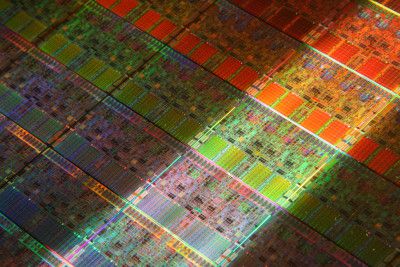From our front-page news:
At an Intel briefing today, we learned a lot more about what to expect when benchmarking Nehalem, and much of it answered the exact questions that have been lingering in my mind for some time. If you read our overview on Nehalem already, then you know the benefits of the tri-channel memory, but what about overclocking?
First and foremost, while the 'ideal' memory configuration for a high-end Yorkfield is 2x1GB DDR3-1600, the ideal solution for Nehalem will be 3x1GB DDR3-1066. Seems weak, but if you read my article last night (and I do recommend it), then you'd know that it's far from being the weak link here. It effectively removes any potential bottleneck, and in most regards, the I/O becomes the new bottleneck (one that's not really seen with RAID'ing multiple SSD though!).
How will you overclock memory on Nehalem, or the CPU for that matter? Well, I'll admit I still don't totally understand how memory is overclocked, or how the frequency is even calculated, but Intel stresses that the skies the limit. The chipset and CPU shouldn't be the weak link, rather it would be the modules themselves.
Going beyond DDR3-2000 speeds should be entirely possible. You might run into weird issues which will likely not be visible with regards to strange dividers, but the overall performance really wouldn't reflect it. That's something we'll specifically have to test once the chip hits the lab.

Contrary to what I mentioned in yesterday's article (oops), the Turbo Mode -does- have something to do with CPU overclocking, but it's a bit odd to explain. Turbo Mode will not be activated in the traditional state during an overclock, but in the BIOS, there will be a Turbo Mode that allows you to increase the figure to increase the overclock. Increasing the Turbo Mode will supposedly be an unlimited affair, but I'm still unsure what exactly that number is going to be based on, but I can definitely say that it's nothing to do with the QPI.
QPI is another thing. It can be overclocked, but Intel highly recommends to not adjust the 133MHz figure, and as far as I'm aware, motherboard vendors are asked to make it clear that adjusting it is dangerous. Even Intel themselves are unsure of what could happen with a highly overclocked QPI over time, but the results are apparently not representative of an ideal system.
There are still a lot of questions hovering around overclocking on Nehalem, and they won't likely be fully answered without real hands-on time with a machine. What I can state with extreme confidence is that Nehalem will be highly overclockable, and enthusiast overclockers will have little to complain about. I've seen ES Extreme Edition samples running at 4.0GHz on a modest air cooler, and I feel rather confident that production samples will act similarly.
First and foremost, while the 'ideal' memory configuration for a high-end Yorkfield is 2x1GB DDR3-1600, the ideal solution for Nehalem will be 3x1GB DDR3-1066. Seems weak, but if you read my article last night (and I do recommend it), then you'd know that it's far from being the weak link here. It effectively removes any potential bottleneck, and in most regards, the I/O becomes the new bottleneck (one that's not really seen with RAID'ing multiple SSD though!).
How will you overclock memory on Nehalem, or the CPU for that matter? Well, I'll admit I still don't totally understand how memory is overclocked, or how the frequency is even calculated, but Intel stresses that the skies the limit. The chipset and CPU shouldn't be the weak link, rather it would be the modules themselves.
Going beyond DDR3-2000 speeds should be entirely possible. You might run into weird issues which will likely not be visible with regards to strange dividers, but the overall performance really wouldn't reflect it. That's something we'll specifically have to test once the chip hits the lab.

Contrary to what I mentioned in yesterday's article (oops), the Turbo Mode -does- have something to do with CPU overclocking, but it's a bit odd to explain. Turbo Mode will not be activated in the traditional state during an overclock, but in the BIOS, there will be a Turbo Mode that allows you to increase the figure to increase the overclock. Increasing the Turbo Mode will supposedly be an unlimited affair, but I'm still unsure what exactly that number is going to be based on, but I can definitely say that it's nothing to do with the QPI.
QPI is another thing. It can be overclocked, but Intel highly recommends to not adjust the 133MHz figure, and as far as I'm aware, motherboard vendors are asked to make it clear that adjusting it is dangerous. Even Intel themselves are unsure of what could happen with a highly overclocked QPI over time, but the results are apparently not representative of an ideal system.
There are still a lot of questions hovering around overclocking on Nehalem, and they won't likely be fully answered without real hands-on time with a machine. What I can state with extreme confidence is that Nehalem will be highly overclockable, and enthusiast overclockers will have little to complain about. I've seen ES Extreme Edition samples running at 4.0GHz on a modest air cooler, and I feel rather confident that production samples will act similarly.
